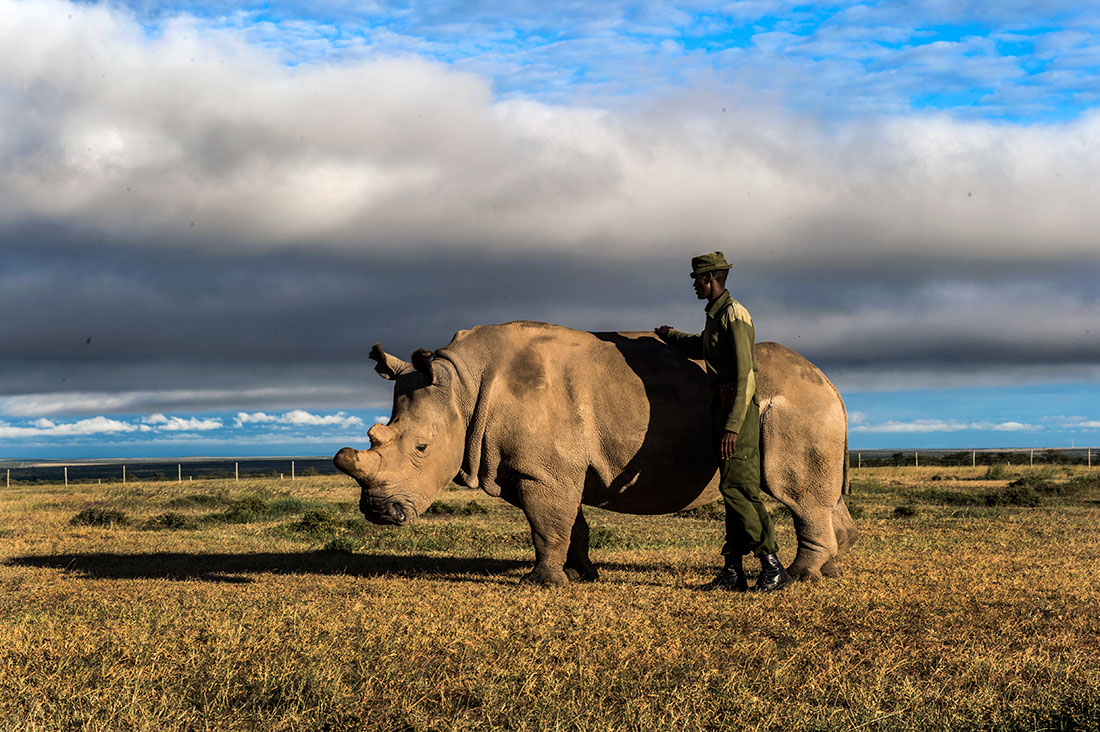One of just three remaining northern white rhinos and the last male of its kind, died last week, marking a sad milestone in the history of the subspecies.

A wildlife ranger at Ol Pejeta looks after Sudan (the last male northern white rhino) and the two remaining females of its kind. The conservancy also protects other rhinos. Photo from: CNN
For decades, rhinos has been severely threatened by poachers, who seek the animal’s signature horn for the high price it delivers on black markets around the world. As a result, today rhinos all over the world are threatened and, of the northern whites, just two remain — both female.
Just a few days before the world lost its last male northern white rhino, the Environmental Film Festival in the Nation’s Capital kicked off with director Kate Brooks’ The Last Animals. This powerful film follows the story of the few remaining members of the subspecies and the conservationists, scientists, and activists who have dedicated their lives to protecting them and others of our world’s most threatened species.
The film brings viewers to the last wild home of the northern white rhino: Garamba National Park in northeastern Democratic Republic of Congo (DRC). Here, poaching continues to threaten the futures of species like the elephant, hunted for their ivory tusks. Every day, dozens of Garamba’s park rangers put their lives on the line to protect these animals and their habitat. Today, many of the warning signs that signaled the end of the northern white rhino are being seen in respect to elephants in Garamba and across Africa and Asia.
The Last Animals urges viewers to demand action to end the poaching crisis and prevent elephants from facing the same fate as the northern white rhino. Just as critically, the poaching crisis must be addressed for the sake of the human communities living among threatened species, because they themselves are threatened as well.
Members of the community of Nagero, where Garamba National Park headquarters are located. Photo from: The Los Angeles Times
Often times, the groups who threaten endangered species in places like Garamba National Park and the groups who threaten the safety of local communities are one in the same. When on poaching missions, groups will often target local populations with violence — looting communities and travelers, sometimes abducting locals, violently forcing them to carry poached ivory and other goods. Through our Early Warning Radio Network, we’ve received countless reports of attacks carried out by poachers while traveling to or from poaching missions.
Poaching also fuels violence and the exploitation of vulnerable communities where it occurs and around the world. Groups like Joseph Kony’s Lord’s Resistance Army (LRA) are known to poach ivory in Garamba, which they then sell or trade to fund their continued violence in the region. Our own LRA Crisis Tracker analysis has used information from the Early Warning Radio Network and survivor testimony to track LRA poaching missions. Many also believe that international terror organizations and organized crime syndicates also engage in poaching and illegally trading in wildlife as a funding stream for their own violence and exploitation around the world.
More than four tons of ivory seized by Togolese authorities in 2014. Photo from: National Geographic
Around the world, leaders and heroes are fighting to save the endangered species whose very existence is threatened by the poaching crisis. The Last Animals introduces audiences to some of those heroes, like Gretchen Peters, who is part of international efforts to prosecute the leaders of poaching organizations, Dr. Samuel Wasser, a zoologist and DNA investigator who has pioneered methods for tracking where illegally obtained was collected, and the rangers at Garamba National Park, who are on the front lines of protecting threatened species.
These heroes are making huge strides, but it’s up to all of us to end global wildlife trafficking and the poaching that threatens wildlife and communities around the world. At Invisible Children, we’ve taken this to heart and are finding ways to be part of the solution.
We’re reimagining some of our most successful programs in order to help the Central African communities most affected by the poaching crisis be a part of ending it. We are working alongside conservation leaders to expand the Early Warning Radio Network to new communities and training local radio operators in how to recognize and use the network to safely report signs of poaching. With information shared through the Early Warning Radio Network, heroes like those at Garamba National Park can more effectively track and stop poachers.
We’re also developing tools to help strengthen the resilience of communities impacted by poaching and related violence. We’re working with local leaders to find ways for their communities to prevent violent conflict and to protect themselves and the wildlife around them so that they can thrive together with their environment.

Community leaders across central Africa are using the Early Warning Radio Network to share information about threats to their safety — including those that come from poachers.
It’s more than likely that our grandchildren won’t know a world with the northern white rhino. But the same doesn’t have to be true for the elephant. Together, we can stop the poaching crisis and save some of our world’s most awe-inspiring creatures as well as countless human lives.
Join us and The Last Animals in taking action to end the poaching crisis before it’s too late.
FIND OUT WHAT LEADERS IN YOUR STATE ARE DOING TO END IVORY TRAFFICKING AND TAKE ACTION TODAY.
Think people should hear about this?